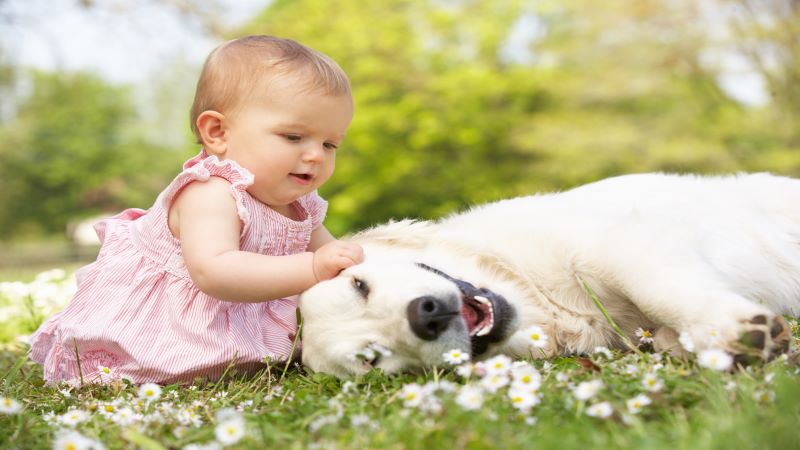After our first child was born, my husband brought home a receiving blanket that had swaddled our little one and the tiny hat that kept his head warm. He let our golden retriever smell them and cuddle them before we brought our new baby home, so that she could become accustomed to the sweet baby smells that would soon invade our living space.
A baby brings a tremendous amount of joy to a family, but also a lot of change. Change can be hard for pets. It is important to prepare cats and dogs for the arrival of the miniature new family member so that they will be receptive (or at least more so).
Preparing your pet for children
When your pet is young (even before you have children) take these steps to prepare your pet for a future family member:
- Gently handle your pet’s tail and ears and gently give restraining hugs. Although ideally you will supervise your child with your pet to ensure your pet is not roughly handled, it is still a good idea to have your pet accustomed to being handled.
- Use a command before allowing your pet to accept treats or food (like okay or release or take it).
- Take your pet to obedience class and/or teach your pet basic commands such as sit, down, leave it, drop it, come and stay.
- Give your pet positive experiences with other children (who know how to be gentle with pets), such as your friends’ children.
Bringing baby home
Before your bring your baby home, slowly change your pet’s feeding, exercise, and quality time schedule to what you anticipate the schedule will be when the baby is home. Dogs are creatures of habit.
When you first bring home your baby, some additional actions will ensure a smooth transition for everyone:
- Mom should greet her pet alone first, without the baby, to prevent the pet from jumping and to reduce jealously. After Mom greets the pet, have another person bring in the baby. Keeping the pet on a leash at first may help control the situation.
- Spend extra time with your pet. Make sure to play and take your dog for walks. Show your dog affection through cuddling sessions, and review basic obedience in fun training sessions with your dog.
- Do not leave your pet alone with your child.
Tips for a happy household
- Continue to give your pet plenty of exercise and attention. Remember that exercise for pets includes both physical and mental exercise. Physical exercise for dogs could include activities such as walks, hikes, swimming or fetch. Mental exercise (for dogs) could include training sessions, eating their meals out of puzzles made for dogs (the dogs move the pieces of the puzzle), chewing on appropriate dog toys such as nylabones, or eating meals frozen into kongs (kibble mixed with canned dog food makes a great kong filler). Just like children, dogs behave better when they are appropriately stimulated. Tired dogs are good, happy dogs!
- Teach your child how to be gentle with your pet and continue to supervise interactions between them. Immediately stop any rough handling or teasing of your pet by your child; pets should not be expected to tolerate rough handling.
- Involve your child in the care of your pet. Some children may assist with feeding, brushing, or changing the water in the water bowl (as appropriate).
- Ensure that good things happen to your pet when the child is around. If your pet ONLY gets attention when the child is not present, the pet will realize that life is better without the child around. Instead, ensure that your pet gets petting, goes on walks, receives treats and meals, and gets attention whenever the child is in the room.
- Give your pet (especially dogs) a place to be. For example, have a special mat or pet bed in the child’s room and in the living room. Many training facilities teach a “go to bed” command. Have your dog lie on this mat or bed when you are in the room with the child. You may want to intermittently reward the dog with kibble when they are in this special place. This will give your dog a place to be but still be able to be around family members without getting underfoot. Pets are creatures of habit; knowing where they should be and what is expected can reduce stress.
- Provide toys for your pet that do not resemble the child’s toys. This will prevent confusion and prevent your pet from taking the child’s toys out of the child’s hand.
Our two-year-old now uses our dog as a pillow, feeds her bones out of his hand, and traipses through the backyard with her at his heels. We didn’t know how she would react to him at first, so we are glad we did many of the things mentioned above to ensure introducing dog to baby would be a smooth operation. Taking the time to be prepared saved a lot of stress when the moment arrived.
Let pet insurance help!
The last thing you want to worry about when bringing home a baby is unexpected vet bills. Enroll your pet in a pet insurance policy so you can focus on building the foundations of a happy family, instead of worrying over veterinary costs. Get a quote today!

